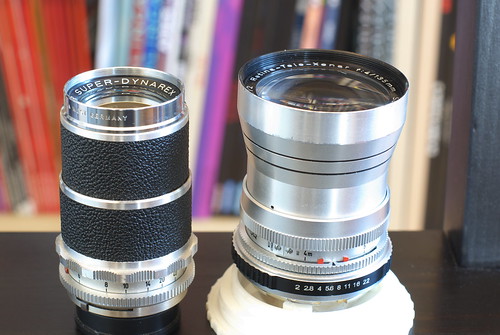135mm Retina lenses: Schneider vs Voigtlander
Among the Deckel-mount lenses available today, the most common are certainly the Schneider Tele-Xenar 135 f/4, originally for the Kodak Retina Reflex, and the Voigtlander Super-Dynarex 135 f/4, for the Bessamatic/Ultramatic SLR series.

Both lenses are made of full metal and glass, the Schneider shining with a nice chrome finish, while the Voitlander shows a more discrete leatherette collar.
Despite the fact that they are almost the same age, their optical scheme is different: the Xenar is a 5 elements in 4 groups, while the Super-Dynarex is a 4 elements in 3 groups. Both are coated lenses and share a shortest focusing distance of about 4 meters or 13 feet, a bit too far when compared to other 135mm lenses of the same age. And both have a fastest f/stop of f/4, most probably because of limitations in the lens mount (a faster lens requires a larger rear optical group).
While sharing the same Deckel mount, the two lenses were not really supposed to be compatible: both Kodak and Voigtlander customized their lens mount with a tab-and-notch system, just to prevent owners from using Retina lenses on Bessamatic cameras and vice-versa.
Nevertheless, the Deckel-M42 adapter i got from Alex from MFLenses forum apparently solved the compatibility issue: both lenses are correctly stopping down, with clicks every half a diaphragm, although the values don't match the scale on the ring (wide open the ring reports f/5.6 instead of f/4 and, on the other side, f/22 is beyond the f/22 on the ring, but this is not really an issue, IMHO).
Having (finally) a bit free time and both lenses available, i decided to make a series of comparative shots.
At first, please forgive the choice of the subject: due to the lack of a garden/courtyard (and to the outside temperature, not really summer-style), i had to cope with my flat and with the limitations imposed by the shortest focusing distance of both lenses. In the test shots, the focus has been set on the snake in the middle, while the egg and the amethyst are used to force some areas with high contrast, to show some chromatic aberration (yes, there is some, as shown in the pictures).
The sample shots are 100% crops from the full size images, developed by Silkypix with the default settings without post-processing, except EV adjust. The camera has been triggered using a remote release cable, with a 2s delay between the mirror up and the shot, and without shake reduction.
I have made my choice between the two lenses but, since i'm not a professional photographer and i'm not claiming to be a reference, your choice it's up to you: feel free to browse the whole series of sample pictures on my Flickr photostream and to download the full size images, to judge by yourself about sharpness, contrast and CA.
Then, if you want, you are welcome to leave some feedback about these two old Germans ...
If you are interested in reading more about these lenses (and a lot of other useful things related to photography), here are some links:
Voigtlander lenses: Taunusreiter site
Schneider lenses: Cameraquest site
Retina-Bessamatic compatibility: Rick Oleson site.
The Deckel adapter comes from MFLenses, you can contact Alex (hk300) or Attila for informations.
Now going to prepare the next year ;-) ...
Labels: Pentax K10D, Schneider Tele-Xenar, Voigtlander Super-Dynarex






0 Comments:
Post a Comment